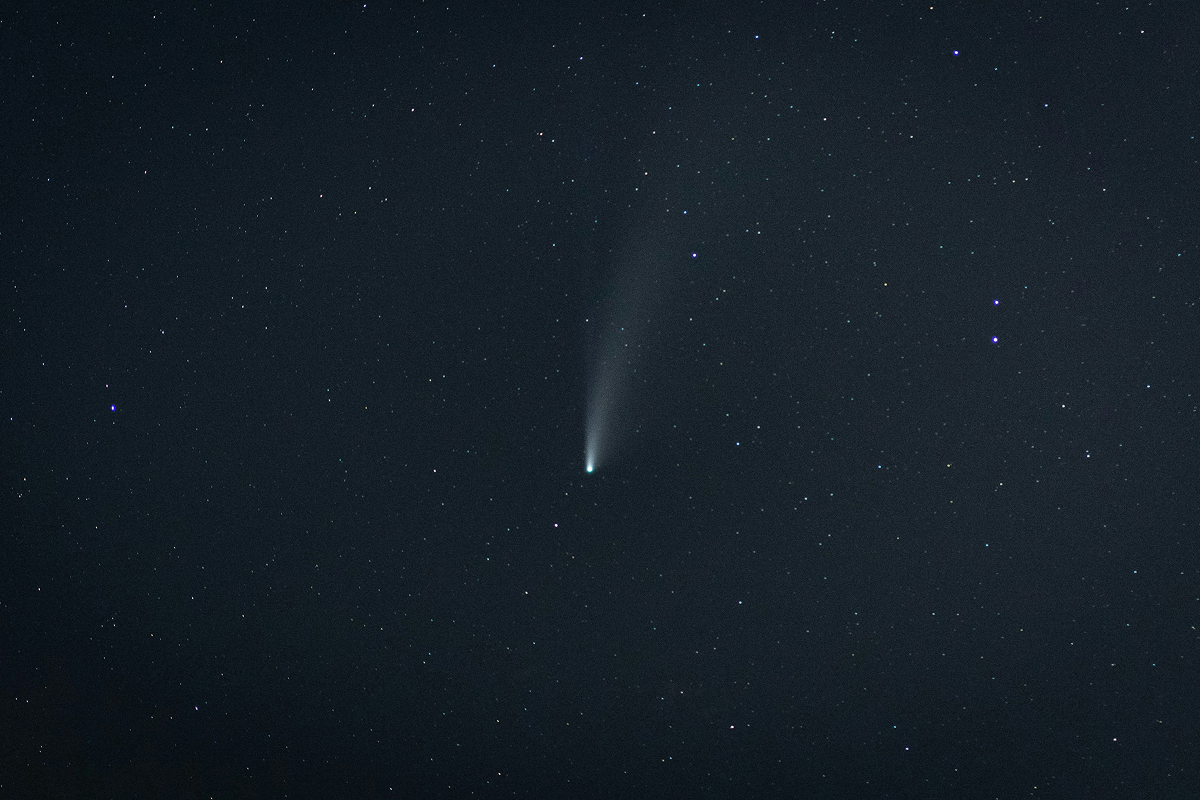New multi-mission images from NASA shed light on the comet’s ancient interstellar origins. Credit: Jay Nlper on Unsplash
A solar system-wide observational mission has given scientists the clearest view yet of the interstellar comet 3I/ATLAS, revealing new clues about its chemistry, its origins, and why the object has sparked weeks of speculation.
From mysterious signals and alien speculation to complete portraits
For the past month, the world has been following the journey of 3I/ATLAS. It is the third interstellar object ever detected in our solar system, and the most puzzling object yet. It’s been blamed for mysterious radio signals, unexplained acceleration, and comparisons to an “alien probe.”
Through the coordinated release of new images and data, NASA has provided the most complete astronomical portrait to date. The agency’s “multi-lens” campaign combines observations from more than a dozen spacecraft and telescopes to create a layered, multi-wavelength view that confirms that 3I/ATLAS is a natural interstellar comet with unusually complex behavior.
The update also reiterates that the comet does not pose a threat to Earth. NASA’s latest orbit shows it will safely pass about 267 million kilometers (267 million kilometers), nearly twice the distance between Earth and the sun, and make its closest approach to Earth around Friday, December 19th.
12 “eyes” to track one-time visitors
What makes the new release so extraordinary is the sheer number of instruments involved. NASA announced that its spacecraft, which traversed the solar system, captured the comet from a variety of angles and wavelengths, from Mars to Earth and into solar orbit.
From Mars, the orbiting satellites MRO (Mars Reconnaissance Orbiter) and MAVEN (Mars Atmosphere and Volatile Evolution Mission) imaged 3I/ATLAS during a flight of approximately 29 million kilometers, revealing a bright core surrounded by active gas jets.
The SOHO (Solar-Heliospheric Observatory) and STEREO (Solar-Terrestrial Observatory) missions tracked the development of a tail that interacts with the solar wind from solar orbit.
NASA’s ATLAS survey telescope and the Hubble Space Telescope, which discovered the comet in July, tracked its brightness and color as it approached the Sun from close to Earth.
The result of this extensive effort is a deceptively simple gallery of images. But each wavelength reveals something different: the heat signature, the structure of dust particles, the chemistry of outgassing, and even the behavior of the comet’s magnetic environment.
Ice celestial bodies formed by cosmic rays
One of the most important discoveries comes from spectroscopy, which breaks down a comet’s light to determine its chemical components.
Data from the James Webb Space Telescope and NASA’s SPHEREx (Spectrophotometer for the History, Reionization Era, and Ice Exploration of the Universe) mission show that 3I/ATLAS contains an unusually large amount of carbon dioxide.
The researchers found that the ratio of CO₂ to water is approximately 7.6 to 1. This is much higher than the ratio seen in typical comets formed in our solar system. Elevated concentrations of carbon monoxide (CO) and traces of other gases such as carbonyl sulfide were also detected.
This chemical reaction is consistent with ice being bombarded with galactic cosmic rays for millions or even billions of years. The radiation slowly changes the comet’s outer layers, producing the unique chemical signatures that scientists are now observing.
This finding is consistent with previous observations suggesting that the comet’s greenish glow, abrupt color change, and early brightening are associated with an irradiated and treated icy surface, unlike the fresher surfaces of comets that formed with the Sun.
Radio waves confirm natural origin
The new observations also solved one of the most debated questions: the comet’s mysterious radio signal.
In early November, astronomers using the MeerKAT radio array in South Africa detected hydroxyl (OH) emissions at 1.665 and 1.667 gigahertz. These radio lines are formed when sunlight breaks down water molecules released from the comet’s core. This is a textbook feature of natural water outgassing.
This detection strongly refutes the theory that 3I/ATLAS may be artifactual. The manufactured objects do not produce the molecular fingerprints associated with evaporating ice.
Combined with the new images, scientists say this theory firmly supports a natural interstellar comet, even if it is extremely rare.
A relic from before the sun was born
Dynamical modeling and chemical clues suggest that 3I/ATLAS formed in a much older star system, perhaps billions of years older than our own, before being ejected into interstellar space.
Telescopes show that the core could be between a few hundred meters and about five kilometers in diameter, making it significantly larger than previous interstellar objects 1I/Oumuamua and 2I/Borisov.
The comet made its closest approach to the Sun in late October and is now retreating toward the outer solar system. It will make its closest approach to Earth at a safe distance on December 19th, then disappear from view and never return.
A once-in-a-lifetime window to another world
NASA’s new data transforms 3I/ATLAS from a speculative mystery to a scientific treasure. Rather than being a smooth, pristine snowball, this comet appears to be covered in ancient ice that has been reshaped by cosmic rays over unimaginable timescales.
As it passes by our Sun in just one visit, it provides a rare opportunity to directly sample different solar system components that were created long before our star lit up the sky.








